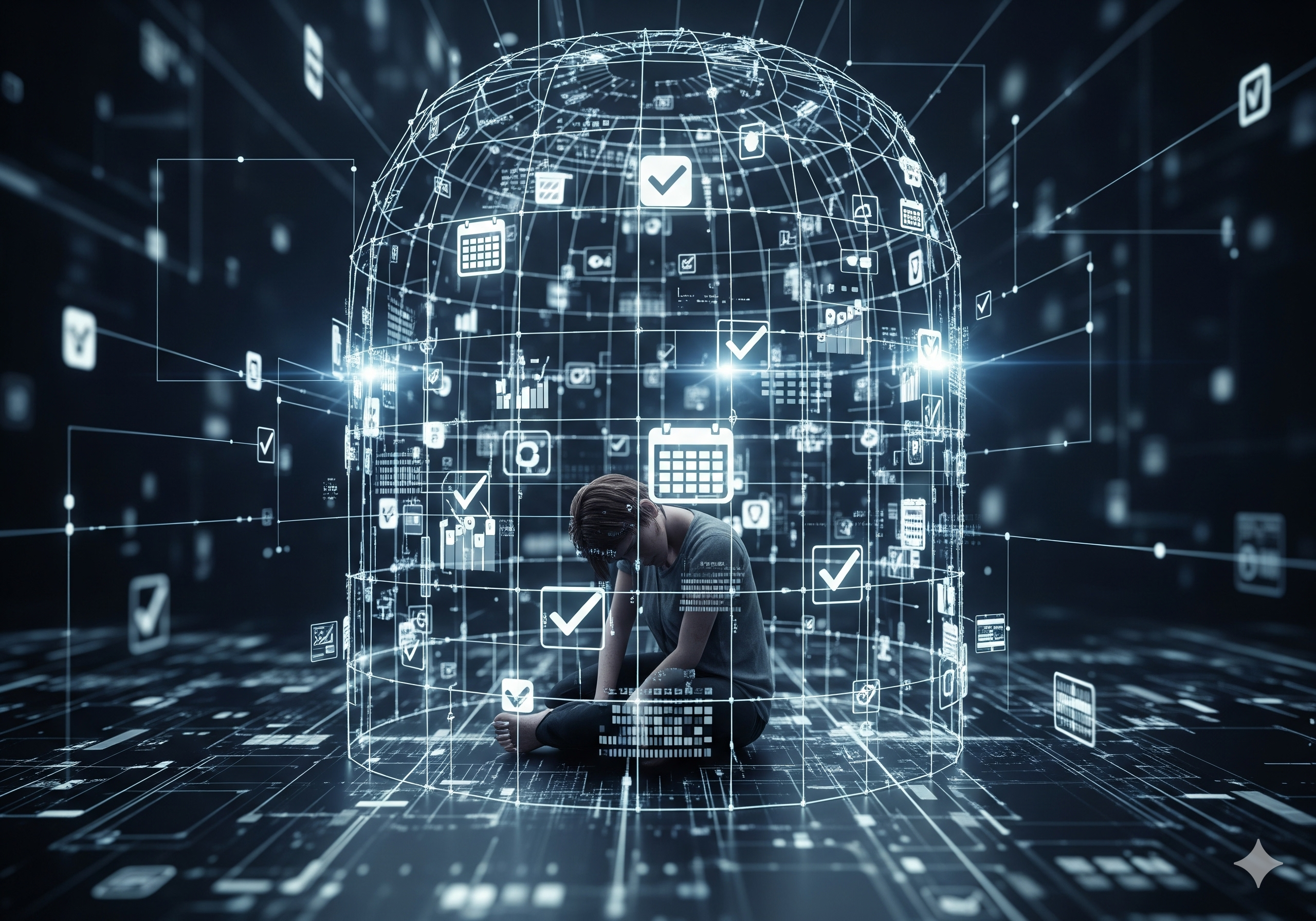In a world of endless distractions, a new savior has emerged: the productivity app. With a tap of a finger, we can manage our to-do lists, track our habits, block distractions, and schedule every minute of our day. These digital tools promise a more organized, efficient, and ultimately, a more successful life. We embrace them as the key to unlocking our full potential, a digital assistant to help us win the war against procrastination.
But what if this promise of ultimate freedom through efficiency is a double-edged sword? What if, in our quest for a perfectly optimized life, we’re becoming more enslaved than ever before? This is the central question we will explore: The Dark Side of Productivity Apps: Are We Truly Free?
This article will delve into the often-unspoken psychological and social costs of our reliance on these apps. We’ll uncover the mechanisms of “productivity guilt” and “surveillance stress,” and discuss how gamification can turn our work into a relentless, joyless pursuit of a perfect score. We’ll examine whether these tools are making us more robotic and less creative, and offer a path forward to reclaim our autonomy in a world obsessed with hyper-productivity.
Background and Context: The Rise of the Digital Taskmaster
The proliferation of productivity apps is a direct response to a hyper-connected world. Our inboxes overflow, social media feeds are a relentless stream of noise, and the demands on our time and attention have never been higher. We feel overwhelmed and seek a way to regain control. For a long time, the solution has been to fight fire with fire: to use technology to manage technology.
Enter the productivity app. From simple to-do lists like Todoist and TickTick to comprehensive project management tools like Notion and Asana, these apps are designed to be our external brains. They promise to offload the cognitive burden of remembering and organizing, freeing up our minds for deep work.
Initially, this promise seems to hold true. The satisfaction of checking off a task, the streak of a successful habit, or the visual of a perfectly organized calendar can be incredibly motivating. This sense of accomplishment is not accidental; it’s by design. Many of these apps leverage the principles of gamification and behavioral psychology, using rewards, points, and streaks to keep us engaged.
However, a growing body of research suggests that this digital taskmaster may be creating new problems as it solves old ones. The very features that motivate us can also create a new kind of pressure and anxiety, leading to a state of perpetual self-surveillance.
The Psychology of “Productivity Guilt”
One of the most insidious side effects of these apps is the creation of “productivity guilt.” By constantly reminding us of our unfinished tasks, our brains are kept in a state of alert. The Zeigarnik Effect—the psychological phenomenon that makes us remember unfinished tasks more than completed ones—is amplified by push notifications and red badges.
When you see a list of uncompleted tasks, a feeling of inadequacy can creep in. You feel like you’re not doing enough, even when you’re working hard. The constant, looming reminder of what you haven’t done can be a significant source of stress, turning a once-simple to-do list into a source of anxiety and shame.
Detailed Comparison: App-Driven vs. Mindful Productivity
The central conflict is not between being productive or lazy, but between two different philosophies of work: the external, app-driven model and the internal, mindful approach.
| Aspect | App-Driven Productivity | Mindful Productivity |
| Source of Motivation | External. Driven by app-based rewards like streaks, badges, and points. The focus is on quantifiable output. | Internal. Driven by intrinsic motivation, a sense of purpose, and the satisfaction of meaningful work. The focus is on quality and fulfillment. |
| Relationship to Time | Optimization. Views time as a resource to be tracked, measured, and filled. Every minute must be accounted for and optimized. | Intention. Views time as a flow to be navigated with purpose. The focus is on being present and focused, not on strict adherence to a schedule. |
| Psychological Impact | Surveillance Stress. Creates a sense of being constantly monitored, leading to anxiety, burnout, and a fear of “wasting” time. | Autonomy & Control. Fosters a sense of personal agency and freedom. Reduces stress by creating a more flexible and humane relationship with work. |
| Creativity | Constraint. Promotes a rigid, linear approach to work. Can stifle the free-form thinking and unstructured time that creativity requires. | Freedom. Encourages unstructured time for reflection and ideation. Recognizes that creativity often happens in moments of “un-productivity.” |
| Tools | Complex all-in-one systems, time trackers, and habit trackers with notifications and gamified features. | Simple tools like pen and paper, a basic calendar, or minimalist apps that serve a single, clear purpose. |
Export to Sheets
The app-driven model is all about the what and the when. The mindful approach is about the why and the how. One can lead to a feeling of being a cog in a machine, while the other can help you feel like the master of your own destiny.
Key Features That Contribute to the “Dark Side”
The very features that are marketed as benefits can have unintended negative consequences.
1. Gamification and the Overjustification Effect
Features like “streaks” and “badges” activate the brain’s reward system, creating a dopamine loop that keeps us coming back. While this can be motivating, it can also lead to the overjustification effect, where an external reward diminishes our intrinsic motivation for the task itself. We stop doing the task because it’s meaningful and start doing it for the “win” in the app.
2. Constant Data Tracking and “Surveillance Stress”
Many productivity apps, especially in a corporate setting, are sophisticated time trackers that monitor every keystroke and mouse movement. This can lead to a form of digital panopticon, where employees feel constantly watched. This “surveillance stress” can lead to anxiety, decreased morale, and an obsession with looking busy rather than doing quality work.
3. The Complexity Trap
Many modern productivity apps are so feature-rich that they create a new kind of procrastination: “meta-work.” Instead of doing the work, we spend hours perfecting our “system”—color-coding tasks, designing custom dashboards, and endlessly tweaking our workflow. The tool, in this case, becomes the task, and we mistake planning for progress.
4. Notification Overload and Cognitive Fatigue
Each notification from a productivity app, whether a reminder or a task update, forces our brain to switch context. Research shows that it can take over 20 minutes to fully refocus after an interruption. A constant stream of notifications from our “productivity” tools can lead to cognitive overload and digital fatigue, leaving us feeling drained and less effective.
Pros and Cons of a Productivity-App Lifestyle
Despite the dark side, it’s important to acknowledge the genuine benefits of these apps. The goal is not to abandon them entirely but to use them with intention and caution.
Pros:
- Improved Organization: For those who struggle with organization, a productivity app can provide a much-needed external structure.
- Enhanced Focus: Features like the Pomodoro timer or website blockers can be powerful tools for deep work.
- Accountability: For many people, a shared to-do list or a public habit tracker can provide the external accountability needed to stay on track.
- Goal Visualization: Seeing a long-term project broken down into smaller, manageable tasks can be incredibly motivating and prevent feelings of overwhelm.
Cons:
- Increased Anxiety and Stress: The pressure to be constantly “on” and productive can lead to burnout and mental health issues.
- Dependency: We can become overly reliant on the app, losing our internal sense of discipline and our ability to self-start.
- Loss of Privacy: Many apps track a wide range of personal data, from your location to your work habits, raising significant privacy concerns.
- Stifled Creativity: Over-structuring your day can eliminate the unstructured, aimless time that is essential for creative breakthroughs and serendipitous ideas.
Use Cases: Who Should Use Them (and Who Shouldn’t)
The key to a healthy relationship with productivity apps is self-awareness.
- Who Should Use Them:
- Project Managers: For managing complex projects with multiple moving parts and team members, a tool like Asana or ClickUp is almost essential.
- Entrepreneurs: A solo entrepreneur needs a way to manage their diverse responsibilities, and an all-in-one tool can provide the structure they need.
- Individuals with ADHD: Many people with ADHD find that an external system can be a game-changer for managing executive dysfunction.
- Who Should Be Wary:
- Creatives: Artists, writers, and designers may find that a rigid system stifles their creative flow. They may be better served by a more flexible, analog system.
- Anyone Prone to Anxiety or Perfectionism: The pressure to “do it all” and the constant reminders of what’s not done can be a major source of stress.
- The “Productivity System” Collector: If you find yourself spending more time setting up new apps than you do working, it’s a sign that you’re in the complexity trap.
FAQs: Your Guide to a Healthier Relationship with Productivity Apps
Are all productivity apps bad?
No. Productivity apps are tools. The problem isn’t the tool itself, but how we use it. A hammer can be used to build a house or to break a window. The key is to use apps with intention and to be aware of their potential psychological downsides.
How can I stop the cycle of “app-hopping”?
The “app-hopping” or “productivity porn” cycle is often driven by a belief that a new tool will solve a deeper, underlying problem. The solution is to simplify. Choose one or two simple, minimalist tools that serve a specific purpose and stick with them for a period of time.
What is “surveillance stress”?
“Surveillance stress” is the anxiety and pressure that comes from feeling constantly monitored. It’s common in workplaces where productivity apps track keystrokes, mouse movements, or time spent on specific tasks.
Is gamification always bad?
Gamification isn’t inherently bad. It can be a powerful motivator. However, when it’s tied to external rewards and not a genuine love for the task, it can diminish intrinsic motivation and turn work into a joyless pursuit of a streak or a point.
What are some alternatives to productivity apps?
Consider a more analog approach. A simple notebook and pen, a physical calendar, or a whiteboard can be powerful tools. The act of physically writing down tasks and crossing them off can be a mindful practice that helps you feel in control without the added stress of a digital device.
Conclusion: A Path to Digital Freedom
The dark side of productivity apps is not a secret conspiracy; it’s an unintended consequence of our desire for control in a chaotic world. In our pursuit of ultimate efficiency, we risk losing our autonomy, our creativity, and our inner sense of calm. The apps we use to free us from distraction can become the very things that bind us.
The final verdict is not a call for a Luddite revolution. It is a plea for a more mindful approach. The goal is not to get rid of your tools, but to be their master, not their servant. Reclaim your time, not by filling every minute with a task, but by giving yourself the space to think, to create, and to simply be. Use these apps as a guide, not a ruler, and you’ll find that true productivity is not about how many tasks you check off, but about how much meaning you find in the work you do.
The Dark Side of Productivity Apps: Are We Truly Free? The answer, it seems, lies not in the apps themselves, but in the freedom we choose to grant ourselves.







Leave a Reply